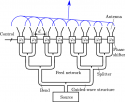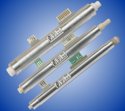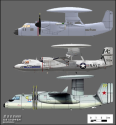I never said PESA is lighter than AESA. What I said is that the weight at the antenna level is larger in AESA than in PESA, because in the former most of the radar is embedded with the antenna, whereas the latter can have the transmitters and receivers located at a distance from the antenna. However, as a system AESA should weigh less than a comparable PESA. If true, they would’ve mounted the arrays much higher on Type 055.
With PESA --- referring only to parallel line feed PESA, for example N011 BARS, not spaced PESA like FLAPLID or MPQ-53, or frequency scan planars like TOP PLATE --- they have to use a line feed for every element, which is a highly shielded cable of the same length, which can be fiber optic. This particular design tends to be weighed down with the network of cables.
Parallel line feed

Spaced or Optical

Another reason for the weight is the use of ferrite phase shifters like this. The line feed cable goes to one end of this, and the other end goes to the antenna.

Instead of the phase shifter being an IC in a PCB. Here you also see the circulator, the LNA for the receiver, the HPA for the transmitter, and an A/D converter, all in just a single small board.

Digital receivers on the array would not be unheard of: that’s also known as a hybrid PESA/AESA radar.
Unfortunately, the manufacturer doesn’t clear this up, other than refering to the transmitter in singular and receiver in plural.
This radar systems handbook also speaks of one transmitter and multiple receivers:
We shouldn’t use the number of articles as proof for a thesis. Granted, there is reason to be suspicious and analysis by analogy weighs more on it being AESA.
If you have a digital receiver for every element, usually there is a circulator down of the antenna that routes the signal to a reciever, which has an LNA to amplify the signal then it goes into an AD converter. Then the receive part of the cycle turns to the transmit and the circulator reroutes the circuit for the transmit part which has an HPA and a phase shifter. Then back again.
On the cutaways shown I don't see a single large transmitter in the plane itself, what's radar related are its computing back end along with its exciter. On the other hand, if you look at the rotodome, there is a separate box behind its large element. It makes more sense to me there is a receiver and transmitter in each box, with a circulator behind each element. The exciter on the main body of the plane makes sure each transmitter marches to the same heart beat. I also don't see parallel line feed cables, and passing radar signals through a rotofeed does not sound like a good idea. You got a cable for every channel, but these cables look digital.

















